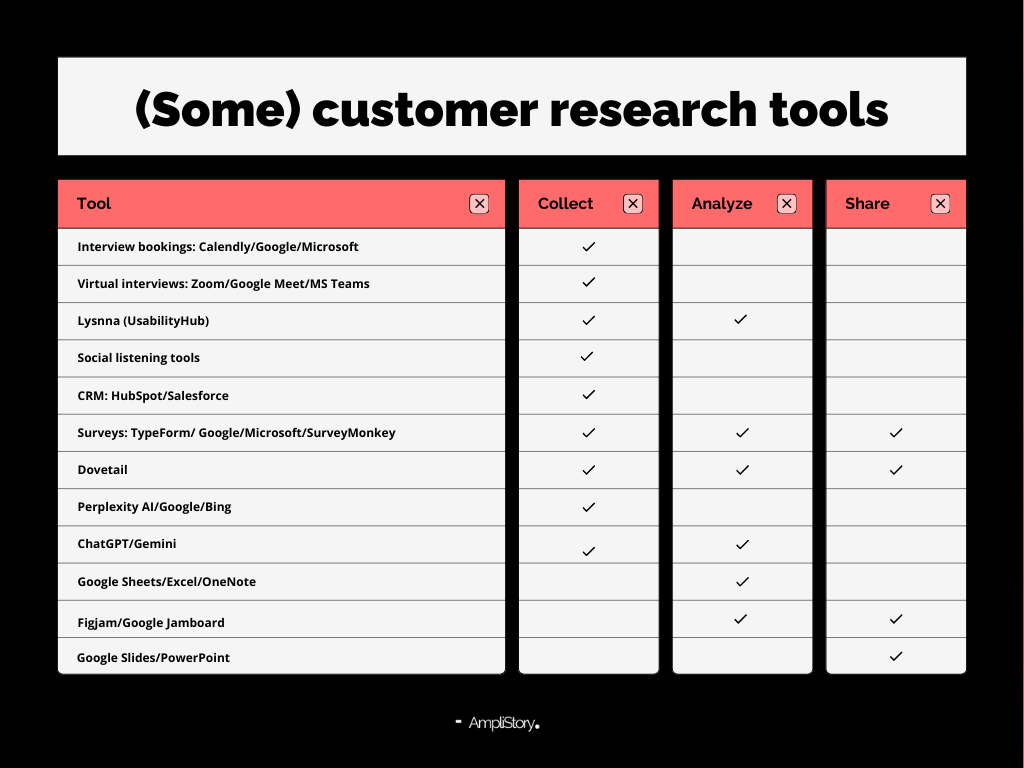Hey there! 👋
Most marketing teams think they know their customers—until a campaign flops or a competitor wins their business. The problem? Too many decisions are based on assumptions rather than real insights. When that happens, messaging falls flat, offers miss the mark, and budgets get wasted.
The fix? Customer research. And you don’t need a big budget or a dedicated team to do it effectively
Before exploring six free or affordable tools and tactics, we need to understand the two main types of customer research and how they work together.
Two Ways to Approach Customer Research
Good research answers two key questions:
- What is happening? (For example, are customers dropping off at a certain stage of the buying process?)
- Why is it happening? (What’s stopping them from moving forward?)
That’s where the two main types of research come in:
- Quantitative research tells you what’s happening by providing measurable data. This includes website analytics, surveys, and structured feedback that can help you identify patterns at scale.
- Qualitative research helps you understand why those patterns exist. It focuses on open-ended conversations, interviews, and direct feedback to uncover emotions, motivations, and obstacles that data alone can’t explain.
The best customer research strategies combine both approaches:
- Use qualitative insights to uncover themes and hypotheses.
- Validate those findings with quantitative data to see how widespread the issue is.
Let’s say website analytics show that many users leave your pricing page without taking action (quantitative). Without speaking to customers, you won’t know if they found the pricing confusing, thought it was too expensive, or were comparing options before deciding (qualitative).
With this information, you can make informed decisions about how to refine your pricing page, for example, simplifying the layout or clarifying the value of each plan. Instead of guessing, you’re making changes based on real customer insights.
6 Essential Resources for Effective Customer Research

1. Surveys & Customer Feedback Tools
Direct feedback is one of the easiest ways to understand what’s working (or not) for your customers. Here are some great tools to help:
- Google Forms (Free). Simple, free, and easy to use for quick customer surveys.
- Typeform (Free & Paid).A more polished, interactive alternative for surveys that feel engaging.
- Hotjar (Free & Paid). Website heatmaps and session recordings to see how visitors interact with your site.
- Jotform & SurveyMonkey (Paid & Free Plans).Good alternatives for more structured surveys.
Pro tip: Keep surveys short—5-10 questions max. Use open-ended questions to uncover insights beyond just numbers.
2. Customer Interviews
The best way to understand your customers is to talk to them. A quick conversation can reveal pain points, motivations, and decision-making processes that you’d never get from a multiple-choice survey.
Get started
- Existing Customers: Reach out via email or LinkedIn.
- Sales & Support Teams: Ask who they frequently interact with and who might be open to a chat.
- Incentives: A gift card or free access to a resource can increase participation.
Questions to ask:
- What was happening in your business when you decided to look for a solution like ours?
- What alternatives did you consider?
- What nearly stopped you from buying?
- What do you wish we did differently?
Pro tip: Aim for 5-10 interviews to identify common themes.
3. Competitor & Industry Research
Understanding your market means knowing what your competitors are doing, and where there’s a gap you can fill.
Useful tools to try
- Google Alerts (Free) and ChatGPT Tasks (Paid): Track mentions of competitors or industry trends.
- Similarweb (Free & Paid): See where your competitors get traffic from.
- G2 & Capterra (Free): Read reviews to see what customers love (or hate) about competitor products.
- Reddit & Industry Forums (Free): Great for unfiltered opinions on common pain points.
Pro tip: Don’t copy competitors—find the gaps they’re missing and position yourself accordingly.
4. Website and behavioural analytics
Numbers don’t lie. Tracking user behaviour can tell you what’s working and what’s confusing your visitors.
Free and affordable tools
- Google Analytics (Free): Essential for tracking website traffic and user behaviour.
- Microsoft Clarity (Free): Free alternative to Hotjar, offering heat-maps and session recordings.
- Crazy Egg (Paid): More advanced website analytics with heat-maps and A/B testing.
Pro tip: Set up goals in Google Analytics (like form submissions or downloads) to track actual conversions, not just traffic.
5. Social Listening & Online Conversations
Customers are talking - you just need to listen.
Where to start
- LinkedIn and X (Free): Follow industry hashtags and conversations.
- AnswerThePublic (Free & Paid): Find common questions people are asking in your space.
- Facebook Groups and Slack Communities (Free and Paid) – Look for discussions about challenges your customers face.
Pro tip: Use customer language from these conversations in your marketing. Speak the way they do, not how your brand thinks they should.
6. Internal Team Insights
Your sales, support, and customer success teams are on the front lines. They hear customer frustrations, common objections, and recurring feedback every day.
How to use this data
- Set up a simple Google Doc where team members can drop common questions or pain points.
- Run a quick monthly or quarterly meeting to review trends.
- If you have a chatbot, export chat logs and look for repeated questions.
Pro tip: Pay attention to objections customers raise before buying. These can be addressed directly in your messaging.
Wrapping up
You don’t need a massive research budget to understand your customers. Start small with one or two of these methods and commit to gathering insights consistently.
Next Step
Choose one tactic from this list and implement it this week. Even a single interview or survey can reveal insights that lead to stronger messaging, better marketing, and ultimately, more sales.